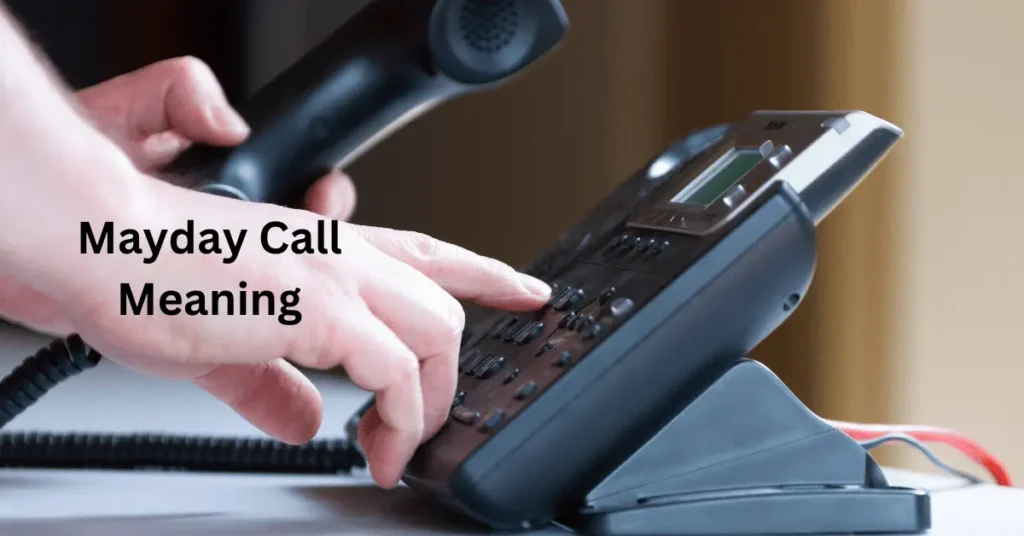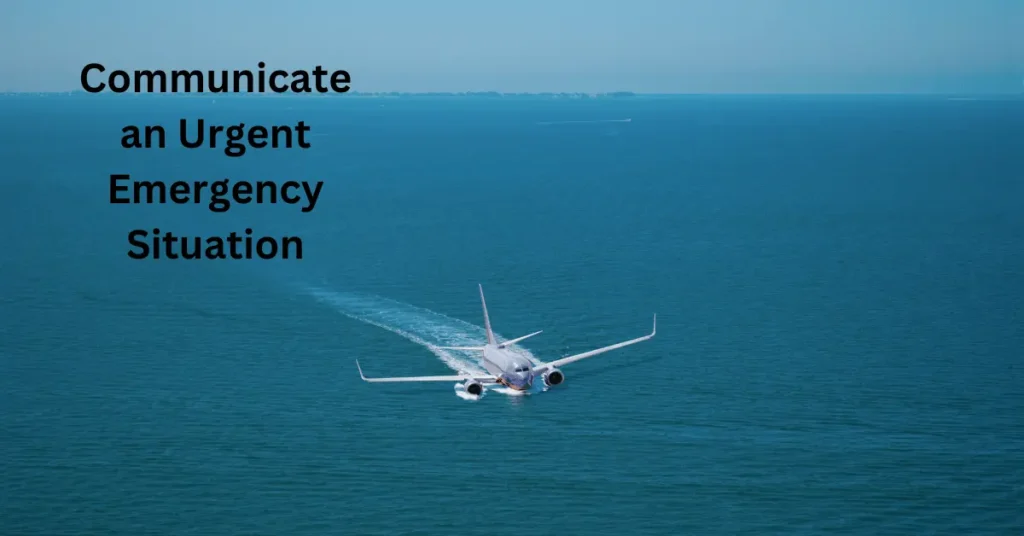Mayday Call Meaning

Have you ever heard the term “Mayday call” and wondered what mayday call meaning is? A Mayday call is a life-saving distress signal used by pilots and boat captains when they find themselves in serious trouble.
It’s their way of saying, “I need help!” In situations where a vessel or aircraft is in danger, a Mayday call is the most urgent and recognized way to get immediate assistance.
This call is more than just a word; it’s a lifeline in times of crisis. In this article, we’ll explore the meaning, history, and importance of a Mayday call, as well as answer some common questions about it. Let’s dive in!
What Does It Mean?
A Mayday call is an internationally recognized distress signal used to communicate an urgent emergency situation, where immediate help is needed. The term “Mayday” is repeated three times to ensure that it’s understood as a critical emergency, rather than a routine message.
It originates from the French word m’aidez, which means “help me.” This simple yet powerful call is used primarily in aviation and maritime industries when a vessel or aircraft faces a life-threatening situation.
When a Mayday call is made, it signals that the person or people in trouble are in immediate danger, and they require assistance right away.
The Mayday call is typically sent via radio communication, using specific frequencies reserved for emergency situations.
Once the call is made, nearby rescue teams—whether they are other aircraft, ships, or ground-based rescue operations—will quickly respond to the distress signal and assist in the rescue effort.
It’s important to understand that the Mayday call is reserved for situations where lives are at risk, and it should never be used lightly.
Whether a ship is sinking, an aircraft is malfunctioning, or someone is in danger at sea or in the air, the Mayday call is the signal that prompts immediate and coordinated action to save lives.
Definition of Mayday Call Meaning
A Mayday call is an emergency distress signal used by pilots, captains, and other personnel in dangerous situations where there is a risk to life or severe damage to a vessel or aircraft.
The term “Mayday” is repeated three times for clarity, distinguishing it from routine messages. It is internationally recognized and used across all countries and languages to signify a critical emergency where immediate assistance is required.
The Mayday call is typically made via radio communication on specific emergency frequencies. It serves as a way for the person in distress to inform others that their situation is life-threatening and urgent help is needed.
This signal triggers swift and coordinated action from nearby aircraft, ships, and rescue operations to provide immediate support.
Examples of Mayday Call Meaning
Aviation Example
Imagine a small private plane flying through the sky when the engine suddenly fails, and the pilot loses control.
The pilot would then use the radio to issue a Mayday call, saying, “Mayday, Mayday, Mayday. This is Cessna 1234. Engine failure.
Requesting immediate assistance. Position: 30 miles east of runway 27.” This call would immediately alert air traffic control and nearby aircraft, prompting them to help guide the plane safely or assist in an emergency landing.
Maritime Example
A cargo ship is sailing through rough waters when it hits an underwater rock, causing a significant hole in its hull.
The captain of the ship would immediately use the radio to broadcast a Mayday call: “Mayday, Mayday, Mayday.
This is the SS Oceanic. Taking on water, sinking. Coordinates: 45°N, 60°W. Immediate assistance needed.”
This Mayday call alerts nearby ships and coastal rescue teams to prepare for a rescue operation and potentially save the crew’s lives.
Other Emergency Situations
Mayday calls can also be used in other extreme scenarios, like mountain rescues or even on land, though this is less common.
For example, a mountain climber trapped in an avalanche might use a satellite phone or radio to call for help, saying, “Mayday, Mayday, Mayday. This is climber X. Trapped in an avalanche. Location: 10 miles north of Base Camp. Need immediate rescue.” This would inform rescue teams to act quickly and help locate and save the climber.
In all these examples, the key aspect of the Mayday call is its urgency. It ensures that others quickly understand the severity of the situation and respond with the necessary resources to prevent further harm or loss of life.
Word Origin of Mayday

The word “Mayday” has a fascinating and somewhat surprising origin that is rooted in both language and practical needs for clear communication in emergencies.
The Mayday distress signal is believed to have been coined in 1923 by Frederick Stanley Mockford, a senior radio officer at London’s Croydon Airport.
At the time, aviation was still in its early stages, and there was a need to develop an effective and easily recognizable distress signal for radio communication.
Mockford was tasked with creating a distress call that would be clear and understood internationally, even by people who didn’t speak English.
Mockford, who was fluent in both English and French, came up with the term “Mayday” because it closely resembled the French phrase m’aidez, which means “help me.”
He reasoned that a distress call needed to be short, simple, and phonetically clear, especially under the high-stress circumstances of an emergency.
The word “Mayday” was chosen because its pronunciation sounded somewhat similar to m’aidez, which could be easily recognized and understood by both English and non-English speakers.
The use of the term quickly gained traction within the aviation community and was officially adopted as the international distress signal for air traffic.
Later, the maritime industry also adopted the Mayday call, solidifying it as a universal emergency signal.
The reason for repeating the word three times—“Mayday, Mayday, Mayday”—was to ensure that it stood out among regular radio traffic and left no room for confusion.
This repetition also helped make it easier for listeners to recognize the urgency of the message.
Interestingly, the word “Mayday” is not connected to the month of May, as the name might suggest. The term’s origin is purely based on phonetics and the French language, and it has no relationship to the holiday or any celebration.
In conclusion, the word “Mayday” has its roots in a combination of practical necessity and linguistic considerations. Its adoption in aviation and maritime communication has since saved countless lives by ensuring that urgent help can be quickly mobilized in times of crisis.
FAQs
What is the difference between Mayday and Pan-Pan?
The key difference lies in the level of urgency. A Mayday call is used in life-threatening situations where immediate help is needed, such as a sinking ship or an aircraft malfunction. On the other hand, a Pan-Pan call is used for less severe situations that are urgent but not life-threatening. Pan-Pan indicates that help is needed, but it’s not an emergency requiring immediate rescue.
Why is the word “Mayday” repeated three times?
The word “Mayday” is repeated three times to ensure clarity and avoid confusion in radio communication. Repeating the distress call ensures that it is immediately recognized as an emergency signal, even in noisy or difficult communication conditions. This repetition helps distinguish the call from other non-urgent messages.
Who can make a Mayday call?
A Mayday call can be made by any individual in charge of a vessel, aircraft, or vehicle that is in imminent danger. This includes pilots, boat captains, and even emergency personnel on land in specific situations. The person making the call needs to be the one facing the danger or in control of the vehicle or vessel in distress.
How do you make a Mayday call?
To make a Mayday call, the person in distress should use the radio to say “Mayday” three times, followed by the details of the emergency. The message should include the nature of the emergency, the location, and any other relevant information such as the type of assistance needed. For example, “Mayday, Mayday, Mayday. This is Ship XYZ. We are sinking, position 45°N, 60°W. Request immediate rescue.”
Can a Mayday call be made on any radio frequency?
No, a Mayday call should be made on designated emergency radio frequencies. In aviation, for example, Mayday calls are broadcast on the international emergency frequency of 121.5 MHz. In maritime situations, ships use the VHF maritime radio frequencies, primarily 156.8 MHz. These frequencies are specifically reserved for distress signals to ensure the call is received by emergency services and nearby vessels or aircraft.
Conclusion
A Mayday call is a crucial distress signal used in emergencies when immediate help is needed.
Whether it’s a sinking ship, a malfunctioning aircraft, or any life-threatening situation, the Mayday call ensures that help arrives as quickly as possible.
Its simple yet urgent nature, with the word repeated three times, helps it stand out and be understood internationally.
Remember, Mayday should only be used in serious emergencies, and using it correctly can save lives.
Extra Points on Mayday Call
- Mayday is International: The Mayday call is recognized worldwide, making it a universal emergency signal. Whether you’re flying in the skies or sailing across oceans, this call ensures that help can come from anywhere, regardless of the language spoken.
- Used for Life-threatening Emergencies: A Mayday call is not for minor problems. It’s only used in situations where someone’s life is in danger or when a vehicle, ship, or aircraft is in imminent danger of damage or destruction.
- Other Distress Signals: Besides Mayday, there are other signals like “Pan-Pan” (used for urgent but not life-threatening situations) and “Securité” (used for safety-related but non-emergency messages). Knowing the difference can help ensure the right level of assistance is given.
- Radio Communication: Mayday calls are usually made via radio communication systems on ships and planes. These radios are tuned to specific emergency frequencies, ensuring the call reaches the right authorities or nearby rescue teams.
- Quick Response Time: Once a Mayday call is made, the nearest available rescue teams—whether ships, planes, or ground crews—are quickly dispatched to the scene. The more accurate the Mayday message, the faster the response.
- Mayday in Popular Culture: The Mayday call is often portrayed in movies and TV shows, highlighting its importance and urgency. While it’s dramatized for effect, the real-world use of Mayday is just as serious and vital in saving lives.